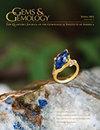A Decade of Ruby from Mozambique: A Review
IF 1.6
3区 地球科学
Q2 MINERALOGY
引用次数: 7
Abstract
the city of Maputo as its capital. It shares borders with Tanzania to the north, Malawi and Zambia to the northwest, Zimbabwe to the west, and Swaziland and South Africa to the south. In the east, Mozambique is separated from Madagascar by the Mozambique Channel, which is part of the Indian Ocean. Many of these countries are known producers of gem corundum. Mozambique joined this club of ruby sources only in the last decade, a mere fraction of its long history. Around 2,000 years ago, Bantu tribes settled in what is now Mozambique. In the eleventh century, traders from the northern shores arrived and set up trading posts. These were mainly Arab, Persian, and Somali merchants who merged their own customs with those of the local Bantu, leading to the development of the Swahili culture along the eastern coast of Africa. In 1498, Vasco da Gama was the first European to arrive in Mozambique, en route to India. He encountered the Arab merchant ruler Mussa Bin Bique, whose name was given to the area. Vasco da Gama’s arrival started the Portuguese influence in the East African country, which lasted until Mozambique gained independence in 1975. This independence sparked a civil war that tore the country apart until the mid-1990s, when its first elections with multiple parties were held. Since these elections, the country has been relatively stable, although insurgent groups are still active. The country’s population of more than 29 million is largely Christian, with a significant number who follow Islam or traditional animistic beliefs. Portuguese remains the official language, though many莫桑比克红宝石十年回顾
马普托市作为其首都。北部与坦桑尼亚接壤,西北部与马拉维和赞比亚接壤,西部与津巴布韦接壤,南部与斯威士兰和南非接壤。在东部,莫桑比克被莫桑比克海峡与马达加斯加隔开,莫桑比克海峡是印度洋的一部分。这些国家中有许多是众所周知的宝石刚玉生产国。莫桑比克在过去十年才加入这个红宝石产地俱乐部,这只是其悠久历史的一小部分。大约2000年前,班图部落定居在现在的莫桑比克。在11世纪,来自北方海岸的商人来到这里并建立了贸易站。这些人主要是阿拉伯、波斯和索马里商人,他们将自己的习俗与当地班图人的习俗融合在一起,导致了非洲东海岸斯瓦希里文化的发展。1498年,瓦斯科·达·伽马(Vasco da Gama)是第一个抵达莫桑比克的欧洲人,当时他正在前往印度的途中。他遇到了阿拉伯商人统治者穆萨·宾·比克(Mussa Bin Bique),这个地区就是以他的名字命名的。达伽马的到来开启了葡萄牙对这个东非国家的影响,这种影响一直持续到1975年莫桑比克获得独立。这种独立引发了一场内战,使这个国家四分五裂,直到20世纪90年代中期,该国首次举行了多党选举。自从这些选举以来,这个国家相对稳定,尽管叛乱组织仍然活跃。该国2900多万人口主要是基督徒,还有相当一部分人信奉伊斯兰教或传统的万物有灵论信仰。葡萄牙语仍然是官方语言,尽管很多
本文章由计算机程序翻译,如有差异,请以英文原文为准。
求助全文
约1分钟内获得全文
求助全文
来源期刊

Gems & Gemology
地学-矿物学
CiteScore
2.90
自引率
19.20%
发文量
10
期刊介绍:
G&G publishes original articles on gem materials and research in gemology and related fields. Manuscript topics include, but are not limited to:
Laboratory or field research;
Comprehensive reviews of important topics in the field;
Synthetics, imitations, and treatments;
Trade issues;
Recent discoveries or developments in gemology and related fields (e.g., new instruments or identification techniques, gem minerals for the collector, and lapidary techniques);
Descriptions of notable gem materials and localities;
Jewelry manufacturing arts, historical jewelry, and museum exhibits.
 求助内容:
求助内容: 应助结果提醒方式:
应助结果提醒方式:


